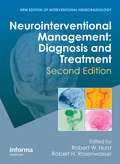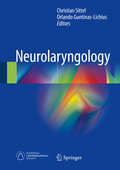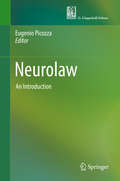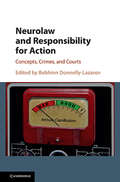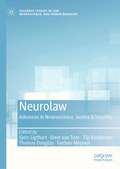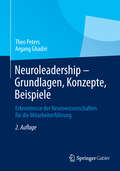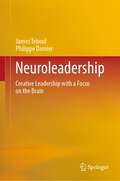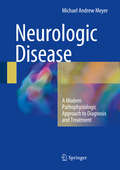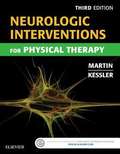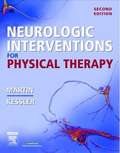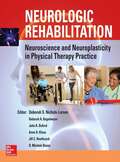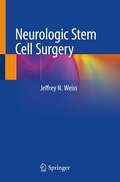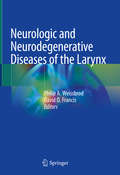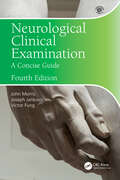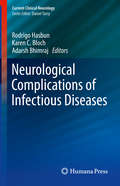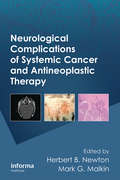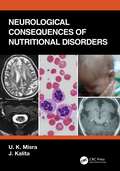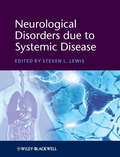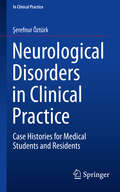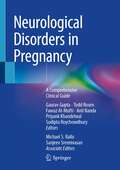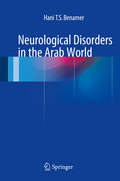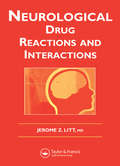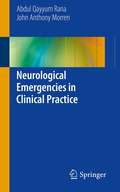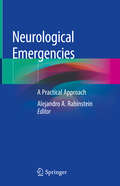- Table View
- List View
Neurointerventional Management: Diagnosis and Treatment
by Robert W. Hurst Robert H. RosenwasserCrossing the boundaries of classically delineated medical and surgical specialties including neurosurgery, neuroradiology, and neurology, Interventional Neuroradiology uses advanced neuroimaging combined with endovascular techniques to guide catheters and devices through blood vessels to treat disease involving structures of the head, neck, and cen
Neurolaryngology
by Christian Sittel Orlando Guntinas-LichiusThis book, endorsed by the European Laryngological Society, is a comprehensive guide to key topics in neurolaryngology, which enables readers to quickly identify and implement solutions in concrete situations likely to arise in everyday clinical practice. It includes detailed information on conditions such as vocal cord paresis/paralysis, laryngeal dystonia, and upper motor neuron disorders and offers clear advice on imaging and assessment, highlighting the role and performance of electromyography. Treatment options are extensively described, and there are individual chapters on functional therapy, botulinum toxin injection, the full range of phonosurgery options (including transoral endoscopic techniques, office-based phonosurgery, framework surgery, and laryngeal reinnervation), and laryngeal transplantation. With numerous accompanying videos, the book is a valuable resource for otorhinolaryngologists, speech pathologists and neurologists.
Neurolaw
by Eugenio PicozzaThis volume illustrates to the public, and legal experts, the basic principles of the field of neuroscience, that commonly goes under the name of Neurolaw. First, it illustrates the relationship between neuroscience, natural sciences and social sciences. Furthermore, it highlights numerous problems concerning the fundamental philosophical concepts used by Neurolaw and evaluates the validity of the method and the limits of a neuroscientific approach to the problems of law and justice. The volume explores the possibility of application of these concepts on the fundamentals of the general theory of law and legal dogmatics. It also examines the main problems of Neurolaw in relation to public, private, criminal and procedural law. In conclusion, the book follows a systematic method that makes it an thorough manual for the introduction to Neurolaw.
Neurolaw and Responsibility for Action: Concepts, Crimes, and Courts
by Dennis Patterson Peter Raynor Donnelly-Lazarov BebhinnLaw regulates human behaviour, a phenomenon about which neuroscience has much to say. Neuroscience can tell us whether a defendant suffers from a brain abnormality or injury, and it can correlate these neural deficits with criminal offending. Using fMRI and other technologies it might indicate whether a witness is telling lies or the truth. It can further propose neuro-interventions to ‘change’ the brains of offenders and so to reduce their propensity to offend. And, it can make suggestions about whether a defendant knows or merely suspects a prohibited state of affairs, so drawing distinctions among the mental states that are central to legal responsibility. Each of these matters has philosophical import; is a neurological ‘deficit’ inculpatory or exculpatory; what is the proper role for law if the mind is no more than the brain; is lying really a brain state, and can neuroscience really ‘read’ the brain? In this edited collection, leading contributors to the field provide new insights on these matters, bringing to light the great challenges that arise when disciplinary boundaries merge.
Neurolaw: Advances in Neuroscience, Justice & Security (Palgrave Studies in Law, Neuroscience, and Human Behavior)
by Gerben Meynen Sjors Ligthart Dave Van Toor Tijs Kooijmans Thomas DouglasThis edited book provides an in-depth examination of the implications of neuroscience for the criminal justice system. It draws together experts from across law, neuroscience, medicine, psychology, criminology, and ethics, and offers an important contribution to current debates at the intersection of these fields. It examines how neuroscience might contribute to fair and more effective criminal justice systems, and how neuroscientific insights and information can be integrated into criminal law in a way that respects fundamental rights and moral values.The book’s first part approaches these questions from a legal perspective, followed by ethical accounts in part two. Its authors address a wide range of topics and approaches: some more theoretical, like those regarding the foundations of punishment; others are more practical, like those concerning the use of brain scans in the courtroom. Together, they illustrate the thoroughly interdisciplinary nature of the debate, in which science, law and ethics are closely intertwined. It will appeal in particular to students and scholars of law, neuroscience, criminology, socio-legal studies and philosophy.Chapter 8 is available open access under a Creative Commons Attribution 4.0 International License via link.springer.com.
Neuroleadership - Grundlagen, Konzepte, Beispiele
by Theo Peters Argang Ghadiri,,Neuroleadership" - international in aller Munde, im deutschsprachigen Raum jedoch bisher nicht wissenschaftlich aufgearbeitet. Diese Lücke schließt dieses Buch, das nun in der 2. , überarbeiteten und aktualisierten Auflage erscheint. Die beiden Autoren beschreiben zunächst den Stand der Forschung und berücksichtigen dabei sowohl die englischsprachige als auch deutsche Literatur. Nach einer Einführung in die neurowissenschaftlichen Grundlagen erfolgt ein Überblick vorhandener Ansätze zum Thema Neuroleadership. Darauf folgt wird ein eigener Ansatz vorgestellt, wie ganzheitliches Neuroleadership auf Organisations- und Personalebene aussehen kann. Abschließend werden aktuelle Forschungsansätze in diesem Themenkomplex vorgestellt. Das Buch verdeutlicht dem Leser, dass wissenschaftliche Grundlagen der Neurowissenschaften die BWL verändern, und zeigt die Anwendung anhand eines konkreten Modells. Denn: Die Erkenntnisse der Neurowissenschaften werden über kurz oder lang auch in die betriebswirtschaftliche Personalarbeit einfließen.
Neuroleadership: Creative Leadership with a Focus on the Brain
by James Teboul Philippe DamierThis book illustrates, through a number of examples from different domains, how to put in place a disciplined process to develop a creative leadership approach. Today's managers seem to have all the tools at their disposal, leadership training, seminars and executive coaching, to exercise effective leadership, but most continue to take the easy path of raw authority, neglecting the interwoven texture of leadership and followership. The classic models of leadership fail routinely because leaders find it hard to develop an effective way of motivating their followers and do not realize how far they are conditioned by the limitations and biases hardwired in their brains. Just like sports professionals who need a good understanding of their body, leaders need to practice and explore the capabilities of their brains. With some knowledge in the latest discoveries in Neurosciences and mastery of their cognitive predispositions, leaders can draw on a range of resources to engage all parties in learning and collaborating towards common goals and create a culture based on cooperation and innovation. Ideal for organizations or associations, private or public companies, this book offers practical advice on neuroleadership through examples of successful transformation including a case study at Netflix.
Neurologic Differential Diagnosis
by Alan B. Ettinger Deborah M. WeisbrotThe increasing pressure upon clinicians to see more and more patients generates great concern as to how to offer a comprehensive and thorough diagnostic approach and yet maintain efficiency. Neurologic Differential Diagnosis is the answer. Unlike other texts which are divided into disease entities, this book uses a case study approach to focus on the patients' symptoms. Each chapter is dedicated to a specific presenting symptom or sign and includes a comprehensive, yet succinct table of clinical features to aid clarification of the broad list of diagnostic possibilities. This allows the clinician to quickly reference specific symptoms such as dizziness, mental status change or diplopia; or signs such as foot drop or psychotic behavior, and then immediately generate diagnostic possibilities. Written from the authors' extensive clinical experience, Neurologic Differential Diagnosis is an invaluable text for neurologists and psychiatrists at all stages of training.
Neurologic Disease
by Michael Andrew MeyerThis novel title explores the central and peripheral nervous system in health and disease. By first establishing a fundamental basic science knowledge about the cellular elements of the nervous system, the reader is then presented with clinical cases in a pathophysiologic manner, as exemplified in unifying Guillain Barre and Multiple Sclerosis in one chapter on Demyelinating Disease. The reader is encouraged to adopt a systematic approach of sorting out neurologic problems he or she may face in clinical practice by identifying time and space factors based on the age of a patient. High quality illustrations for each case are included in the book along with novel three-dimensional reconstructions of MR, PET, and CT data whenever possible. Developed largely for medical students as an introduction to the clinical neurosciences, for neurology residents, and for others doing graduate level neuroscience study, Neurology - A Modern, Pathophysiologic Approach to the Diagnosis and Treatment of Neurologic Disease will also be of significant interest to the established neurologist as a comprehensive, up-to-date reference.
Neurologic Interventions for Physical Therapy
by Mary Kessler Suzanne Tink" MartinMaster the role of the physical therapist or physical therapist assistant in neurologic rehabilitation! Neurologic Interventions for Physical Therapy, 3rd Edition helps you develop skills in the treatment interventions needed to improve the function of patients with neurologic deficits. It provides a solid foundation in neuroanatomy, motor control, and motor development, and offers clear, how-to guidelines to rehabilitation procedures. Case studies help you follow best practices for the treatment of children and adults with neuromuscular impairments caused by events such as spinal cord injuries, cerebral palsy, and traumatic brain injuries. Written by physical therapy experts Suzanne 'Tink' Martin and Mary Kessler, this market-leading text will help you prepare for the neurological portion of the PTA certification exam and begin a successful career in physical therapy practice. Comprehensive coverage of neurologic rehabilitation explores concepts in neuroanatomy, motor control and motor learning, motor development, and evidence-based treatment of adults and children with neuromuscular impairments.
Neurologic Interventions for Physical Therapy (Second Edition)
by Mary Kessler Suzanne Tink MartinNow completely updated with the latest information on both adult and pediatric patients, this comprehensive book provides a link between the pathophysiology of neurologic deficits and possible rehabilitation interventions for improving movement outcomes. It introduces the structure and function of the nervous system and describes normal motor development, motor control and motor learning, pathophysiology of the nervous system and common treatment techniques used in physical therapy practice. This edition also features updated terminology from the APTA's Guide to Physical Therapist Practice, as well as new chapters on proprioceptive neuromuscular facilitation (PNF) and other neurological conditions seen in the adult. Helpful learning aids and abundant illustrations highlight key concepts and help readers quickly master the material. Helpful learning aids - such as objectives, tables, illustrated intervention boxes, and review questions - reinforce important facts and concepts. Review questions at the end of each chapter allow readers to test their understanding of the material. 700 illustrations clearly depict procedures discussed in the text and clarify descriptions of anatomy, physiology, evaluation, pathology, and treatment. Background information is provided for interventions that can be used in the rehabilitation of adults and children, promoting a complete understanding of techniques. Careful documentation uses current outcomes-based research. Case histories include subjective and objective observation, assessment, planning, and critical decision-making components. Current language of the APTA's Guide to Physical Therapist Practice, 2nd Edition is used throughout, aligning all information with best practices put forth by the APTA. A new chapter on proprioceptive neuromuscular facilitation (PNF) describes how these techniques can be used to improve performance of functional tasks by increasing strength, flexibility, and range of motion.
Neurologic Rehabilitation: Neuroscience And Neuroplasticity In Physical Therapy Practice
by Deborah S. Nichols Larsen Deborah K. Kegelmeyer John A. Buford Anne D. Kloos Jill C. Heathcock D. Michele BassoNeurorehabilitation in Physical Therapy delivers comprehensive coverage of the structure and function of the human nervous system. It also discusses normal motor development and motor control, as well as common treatment techniques in physical therapy. In order to be engaging to students, cases open each chapter, with questions about those cases appearing throughout the chapter. The text includes numerous tables, flow charts, illustrations, and multiple-choice board-style review questions and is enhanced by a roster of world-renowned clinical contributors.
Neurologic Stem Cell Surgery
by Jeffrey N. WeissThis is a concise how-to of successfully treating previously poorly or untreatable neurologic conditions with stem cell therapies. The text examines the IRB approved protocols of NEST (Neurologic Bone Marrow Derived Stem Cell Treatment Study), SCiExVr (Stem Cell Spinal Cord Injury Exoskeleton and Virtual Reality Treatment Study), and ACIST (Alzheimer’s and Cognitive Impairment Stem Cell Treatment Study). The discussion focuses on the protocols and informed consents and may be used as a template for specialists to develop clinical trials utilizing stem cell based therapy. Other potential noninvasive treatments for brain injury are also discussed. Neurologic Stem Cell Surgery, the sister text to the recently published Retinal and Optic Nerve Stem Cell Surgery, is an invaluable reference for all physicians with an interest in the development of stem cell based treatments.
Neurologic and Neurodegenerative Diseases of the Larynx
by Philip A. Weissbrod David O. FrancisThis comprehensive text summarizes what is known about the myriad of different neurological conditions that cause dysfunction of communication, swallowing, and breathing as it relates to the upper aerodigestive tract. It serves to provide clinicians and scientists, at all levels of experience, a practical and thorough review of these diseases, their management, and frontiers in science. Chapters are written by experts in these conditions from a broad spectrum of medical specialties in order to create a book that is inclusive of diagnostic and therapeutic considerations that clinicians should think about when caring for patients with these conditions. Neurologic and Neurodegenerative Diseases of the Larynx will be an instrumental resource in guiding clinicians to better recognize the subtle and not so subtle voice, swallowing, and airway manifestations of these diseases, and improve management of patient symptoms and concerns in order to maximize both quality of life and longevity. It will aide otolaryngologists, laryngologists, neurologists, speech language pathologists, and other allied health care professionals in developing a more efficient, evidence-based, patient-focused, and multi-specialty approach to managing these complex and challenging patients.
Neurological Clinical Examination: A Concise Guide
by John Morris Joseph Jankovic Victor FungThis book and video collection provide a practical guide to the clinical neurological examination, an essential tool in the diagnosis of neurological conditions encountered in the outpatient clinic and hospital ward. Each chapter covers a different condition and uses a step-by-step approach selecting those aspects of the clinical examination which are most likely to lead to the correct diagnosis. Video clips accessible via both a companion website and by QR codes within the book provide easy access to view a wide range of neurological signs. The text is illustrated with clear diagrams. Tables are used to list the various causes of particular signs. Primary care physicians, neurologists, and trainees preparing for certifying examinations will find this book an invaluable learning companion and essential tool for the diagnosis of neurological disorders.
Neurological Complications of Infectious Diseases (Current Clinical Neurology)
by Rodrigo Hasbun Karen C. Bloch Adarsh BhimrajThis book offers a comprehensive review of the most common infectious diseases that affect the nervous system. Written by international experts, it provides a guide to clinicians for accurately diagnosing and treating these challenging syndromes. Organized into six sections, the book presents didactic, up-to-date information on the following topics relating to central nervous system (CNS) infections: diagnosis and evaluation of the patient, bacterial, viral, fungal and mycobacterial infections, disorders of the spinal cord, and a myriad of miscellaneous infections. Chapters specifically reflect and look to resolve the common obstacles clinicians face in the field, such as having unknown etiologies on the majority of CNS infections, insensitive and slow microbiological techniques, an increasing number of immunosuppressed individuals with atypical presentations and pathogens, and a lack of standardized diagnostic algorithms. A complex yet accessible addition to the Current Clinical Neurology Series, Neurological Complications of Infectious Diseases invaluably examines a wide range of infections that have neurological complications and sequelae.
Neurological Complications of Systemic Cancer and Antineoplastic Therapy (Neurological Disease and Therapy)
by Herbert B. Newton Mark G. MalkinNeurological Complications of Systematic Cancer and Antineoplastic Therapy provides an in-depth review of common manifestations related to neurology that occur in patients with systemic cancer. These include brain metastases, spinal cord compression, cerebrovascular events, and leptomeningeal disease. The book also discusses less common complicatio
Neurological Consequences of Nutritional Disorders
by U. K. Misra J. KalitaThis book focuses on the impact of nutritional disorders on the nervous system. Nutritional disorders are caused due to poverty, famine, infestations, ignorance in the developing world and due to food faddism, isolation, depression, addictions, and comorbidities in the developed countries. This book has chapters on various disorders covering basic knowledge, their clinical manifestations, basis and etiology, laboratory diagnosis, method of treatment and prognosis. It provides the guidelines to students and clinicians for dealing with such disorders which are easily preventable and amenable to treatment whose early diagnosis and management can avert morbidity and mortality. Key Features Deals with the unexplored topic of the neurological impact of nutritional disorders Will be essential for neurologists, general physicians, and pediatricians Includes key illustrated examples from authors' clinical practice.
Neurological Disorders due to Systemic Disease
by Steven L. LewisHow do you identify which neurological syndromes occur due to systemic disease? Neurological problems commonly occur in the context of underlying systemic disease, and may even be the presenting symptom of a medical condition that has not yet been diagnosed. Consequently neurologists need to be aware when a neurological presentation might indicate an underlying systemic disorder. Neurologic Disorders due to Systemic Disease provides the tools you need to make these connections. The unique Neurologic presentations-based approach relates to the common clinical situations you encounter, including: Headache Stroke Movement disorders Neuromuscular disorders Encephalopathies, Seizures, Myelopathies, Neuro-Ophthalmologic and Neuro-otologic disorders, Sleep disorders, and others Major categories of systemic illness are explored for each presentation to guide you towards a likely cause. These include: Endocrine, electrolyte, and metabolic disorders Systemic autoimmune disorders Organ dysfunction and failure, and critical medical illness Systemic cancer and paraneoplastic disorders Systemic infectious disease Complications due to drugs and alcohol Vitamin and mineral deficiencies Written by a leading cast of experts, with a practical approach including ‘things to remember’ for each presentation, Neurologic Disorders due to Systemic Disease should be on every neurologist’s desk.
Neurological Disorders in Clinical Practice
by Şerefnur ÖztürkThis book promotes the importance of a carefully obtained patient history when making a neurological diagnosis and explains the effects of disease symptoms on the patient's daily life. Communication between doctor and patient through active listening, observation and problem solving skills will be improved. Based on real patients suffering from the most common neurological disorders, these fictional case histories provide an understanding of initial symptoms and disease progress from the point of view of the patients and their relatives. Neurological Disorders in Clinical Practice: Case Histories for Medical Students and Residents is aimed at medical students, neurology residents, family practitioners, and those interested in medical teaching and training.
Neurological Disorders in Pregnancy: A Comprehensive Clinical Guide
by Gaurav Gupta Anil Nanda Fawaz Al-Mufti Todd Rosen Priyank Khandelwal Sudipta Roychowdhury Michael S. Rallo Sanjeev SreenivasanThis book is a collection of the latest data and papers on neurological disorders during pregnancy. These complicated and difficult conditions require a multi-disciplinary approach to treatment, which may either be surgical intervention or medical management. For women in the reproductive age group, the diagnosis of neurological disorders during pregnancy or post-partum creates further challenges Taking motivation from the Editor’s successful management for pregnant cases with neurological disorders, this book is intended to guide the neurosurgical community towards better management of treating neurological disorders in pregnancy.
Neurological Disorders in the Arab World
by Hani T. S. BenamerAfter graduating from Tripoli, Libya in 1990, Dr Benamer came to the United Kingdom in 1991 to further his training in medicine. He obtained the MRCP in 1994 and trained in neurology in Glasgow. He obtained a PhD and CCST in 2000 and was appointed a consultant neurologist in Wolverhampton and Birmingham the same year. He has been the lead neurologist in New Cross Hospital in Wolverhampton since 2006. Dr Benamer is a general neurologist with special interest in movement disorders. Dr Benamer is honorary clinical senior lecturer in Birmingham University and has an interest in medical education, in which he obtained a postgraduate certificate from Keele University in 2007. He has published more than 35 papers and two books. He is currently a senior editor of the Libyan Journal of Medicine. He was also an examiner of the MRCP Diploma from 2005 to 2009. Dr Benamer's publications relevant to the subject of the book: 1. Benamer HT. 2007. Neurological disorders in Libya: an overview. Neuroepidemiology 29:143-9 2. Benamer HT. 2008. The ancestry of LRRK2 Gly2019Ser parkinsonism. Lancet neurology 7:769-70; author reply 70-1 3. Benamer HT, de Silva R, Siddiqui KA, Grosset DG. 2008. Parkinson's disease in Arabs: a systematic review. Movement disorders: official journal of the Movement Disorder Society 23:1205-10 4. Benamer HT, Ahmed ES, Al-Din AS, Grosset DG. 2009. Frequency and clinical patterns of multiple sclerosis in Arab countries: a systematic review. Journal of the neurological sciences 278:1-4 5. Benamer HT, Grosset D. 2009. Stroke in Arab countries: a systematic literature review. Journal of the neurological sciences 284:18-23 6. Benamer HT, Grosset DG. 2009. A systematic review of the epidemiology of epilepsy in Arab countries. Epilepsia 50:2301-4 7. Benamer HT, Shakir RA. 2009. The neurology map of the Arab world. Journal of the neurological sciences 285:10-2 8. Benamer HT. 2010. Neurology expertise and postgraduate training programmes in the Arab world: a survey. European neurology 64:313-8 9. Benamer HT, de Silva R. 2010. LRRK2 G2019S in the North African population: a review. European neurology 63:321-5 10. Benamer HT, Deleu D, Grosset D. 2010. Epidemiology of headache in Arab countries. The journal of headache and pain 11:1-3 11. Benamer HT. 2011. More epidemiological studies of neurological disorders are needed in the Arab countries. Neuroepidemiology 36:70.
Neurological Drug Reactions and Interactions
by Jerome Z. LittA must-have resource for the doctor's office and hospital consultations, this handy pocket reference describes and catalogs the adverse effects of commonly prescribed and over-the-counter generic drugs and herbals used in neurology.
Neurological Emergencies in Clinical Practice
by Abdul Qayyum Rana John Anthony MorrenNeurological Emergencies in Clinical Practice discusses neurological emergencies in a stepwise fashion including stabilizing the patient, identifying the cause, and treating the underlying cause. It is useful in several settings including the emergency room, hospital in-patient service as well as the intensive care unit. Neurological Emergencies in Clinical Practice has a wide appeal and relevance to disciplines including neurology, emergency medicine, critical care medicine, internal medicine and family medicine. Medical students and residents may use this convenient, pocket-sized book to prepare for and succeed in their training examinations and it is also useful for other house staff and practicing physicians.
Neurological Emergencies: A Practical Approach
by Alejandro A. RabinsteinThis comprehensive and up-to-date book covers the common emergencies in neurology, neurosurgery, and psychiatry. Chapters examine a variety of neurological emergencies, and offer pragmatic approaches to treatment and management. High-quality tables, figures, and algorithms supplement expertly written text, and provide readers with clear, rapid answers in an easily accessible format. Additionally, the book includes discussions on less common conditions, and incorporates specific methods for treating specific populations, such as pregnant women and transplant patients. Neurological Emergencies: A Practical Approach is a go-to reference for all medical professions working in emergency treatment settings, and will increase their ability to better care for patients with acute neurological diseases.
